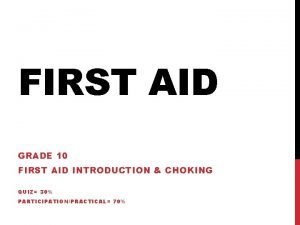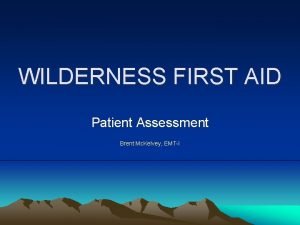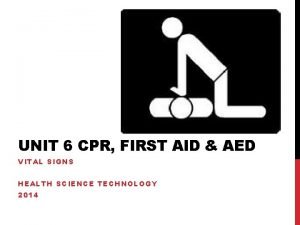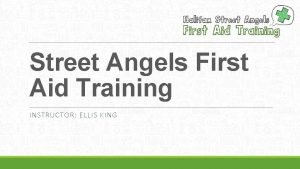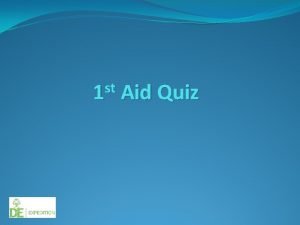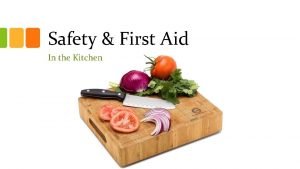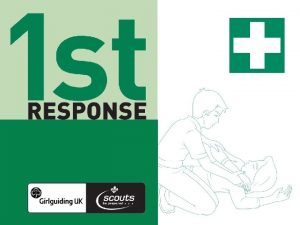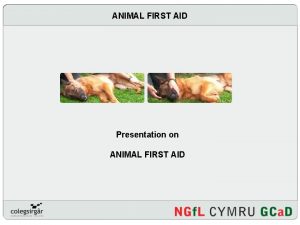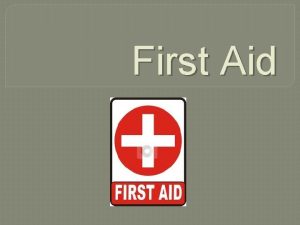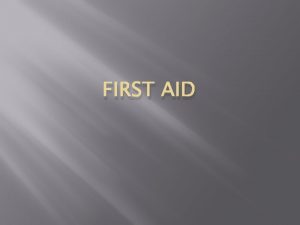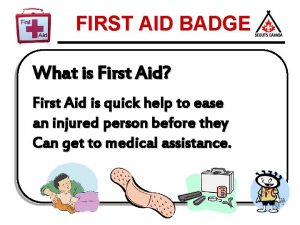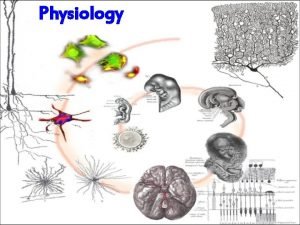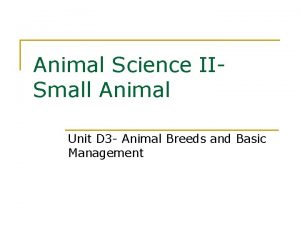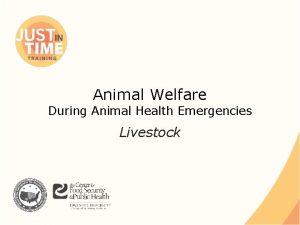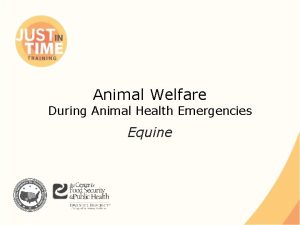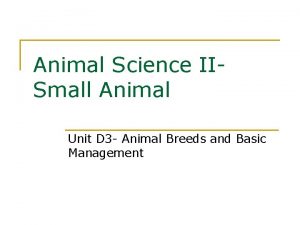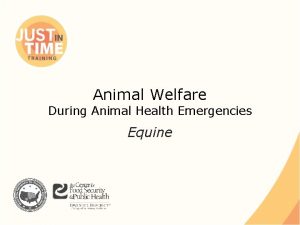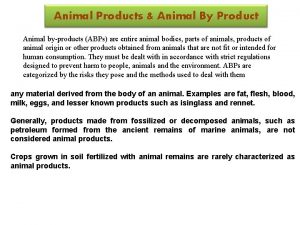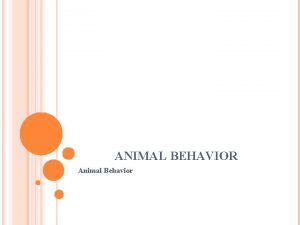Animal First Aid What is First aid FIRST



















- Slides: 19

Animal First Aid

What is First aid? “ FIRST AID IS THE IMMEDIATE TREATMENT OF INJURED ANIMALS OR THOSE SUFFERING FROM SUDDEN ILLNESS “

Why is first aid important? § The aims of first aid are: To preserve life To prevent the situation deteriorating To reduce pain and suffering To promote recovery

Preventing measure during first aid • Before administering first aid, assess the situation for danger to yourself or others. • Injured animals are usually in pain and may bite. Make sure that the animal is correctly restrained before handling or lifting. • NEVER put yourself or others at risk.

Classification of Emergency Life-threatening emergencies An emergency can be classified as one of three types: • These require immediate action by the owner or first aider at home, and the vet and nurse at the surgery. Minor • Emergencies requiring at the surgery but where life is not immediately threatened. prompt attention • where telephone advice and first aid enables the owner to keep the animal comfortable until an appointment with a veterinary surgeon.

First Aid given to Dog Minor Emergency

ABC of First Aid § AIRWAY § Check that the airway is clear § Pull the tongue forward § Remove any collar or hardness § BREATHING § Look and listen § If the animal is not breathing, proceed with artificial respiration § § CIRCULATION § Check the heartbeat/pulse § Apply regular, intermittent gentle pressure to the chest if you are sure there is no heartbeat

ABC of First Aid § As soon as the airway, breathing and circulation have been assessed any necessary action taken: § Control any severe haemorrhage. Pressure can be applied using a bandage, a towel, or even your hand § Check the animal’s level of consciousness § Treat for shock by keeping the animal warm. This is best done by covering the animal in a blanket to conserve body heat.

First Aid Kit Absorbent cotton Adhesive tape Antiseptic scrub Disposable latex gloves Disposable razor Duct tape Dusting powder Epsom salt

First Aid Kit § Dog muzzle (or length of non-stretch bandage) § Swabs § Nail clippers to cut overlong or broken nails § Antiseptic wash e. g. Hibiscrub § Round-ended scissors § Salt – to clean wounds mix 1 teaspoon of salt to 1 pint of water § Cotton wool § Thermometer & lubricant § Sticky tape

First Aid Kit § Address and telephone number of veterinary practice § Leaflet containing basic first aid advice – to use as a reference § Dog lead § Buster collar For larger animals it is also useful to have : § Access to a rug or blanket that can be used as a stretcher

How to identify snake bites § When a sheep is bitten by a poisonous snake the animal will experince diffculty swallowing the tongue will protrude limply from the mouth and the animal will dribble saliva § Goat show less sensitivity to snake venom. how ever goat can die from puff adder bites § A healthy chow less likely to succumb to the effect of venom then and older individual in poor health. where it was bitten is also important.

§ As the animal are exremely sensitive to venom it whould appear that death occur only with multiple bite § Other fector that play important role include the amount venom injected the size of the snake and the animal age and health of the animal

First aid § Before calling the vet, try and determine if the animal has acutually been bitten by a venomous snake. although it may be difficult to locate the bite due to the hair on the animal, s body bleeding or swelling are good sign to look out for § A bite from a venomous snake will leave two quit distinctive puncture wounds which will bleed profusely in the case of a puff adder bite § a bite from non venomous snake will probably leave no teeth marks result in multiple puncher wounds and copious bleeding

§ If the animal has been bitten in the nostrils or muzzle, these areas will swell, making it difficult for the animal to breathe. Pass a piece of clean tubing up the nostrils to maintain an open airway. Where the animal shows signs of paralysis, breathing down the tube will help keep it alive until the vet arrives. § Keep the animal calm, as an increased heart rate will spread venom through the body much more rapidly. Let the vet come to the animal rather than trying to walk it to a more accessible spot, as this will only increase its heart rate. § Never cut the wound and try to suck out the venom. If you have a cut in your mouth, you’ll be poisoned as well §. In the case of a cobra bite (excluding the Mozambique spitting cobra), apply a pressure bandage over the bite and wrap it up to the top of the limb. This is not a tourniquet as its aim isn’t to stop blood flow, but to slow down the venom’s absorption into the lymph system. (If applied to a viper bite, where swelling develops, this will do more harm than good. ) § Do not apply a hot or cold compress, as this could damage the tiss

Drowing § Suffocation by drowning is caused by lungs filling with water or other fluid. Some pets can seemingly recover from a near drowning incident, only to succumb to a collection of fluid in the lungs (known as pulmonary edema) hours later. This phenomenon is known as ‘dry drowning’ and can be fatal

Procedure § Remove him from the water. § Place him on his side with his head and neck extended. It's preferable to have the head slightly lower than the body to promote drainage of water from the lungs and to avoid inhalation of stomach contents (aspiration). § To expel water from the lungs and stomach, pull the tongue forward and gently push on the chest wall and stomach. Take care to avoid being bitten. § Cover the pet with a blanket to avoid further heat loss.

Heatstroke § High body tempure § Distress § Excessive panting § Excess saliva § Bluish purple or bright red gums due to inadequate oxygen supply to the tissue

Procedure of first aid § Cool your pet on your way to the vet. , Get them in the car to the vet and run the air conditioning to keep them cool. You can also use a spray bottle to lightly cool them with water. Do not submerge your pet in ice water as this can be more dangerous. § Get them drinking. If your dog is able to drink, give him or her a large bowl of water. § Seek veterinary attention. Heatstroke is a serious condition that requires immediate attention and intensive care is generally required to save your pet’s life. Intravenous fluids cool the body, maintain blood pressure, support the kidney system and generally help speed recovery. Any initial home treatment greatly increases the chance of surviving but it is only in mild cases that the initial home treatment is sufficient.
 First aid merit badge first aid kit
First aid merit badge first aid kit What are the objectives of first aid?
What are the objectives of first aid? St andrew medical centre
St andrew medical centre Plant vs animal mitosis
Plant vs animal mitosis Plant vs animal cells venn diagram
Plant vs animal cells venn diagram Similarities between animal rights and animal welfare
Similarities between animal rights and animal welfare First aid patient assessment form
First aid patient assessment form Air cadets badges
Air cadets badges Hypertension vs hypotension
Hypertension vs hypotension Unit 15:4 providing first aid for shock
Unit 15:4 providing first aid for shock Coyne first aid
Coyne first aid Taz hartwick
Taz hartwick Three ps in first aid
Three ps in first aid First aid quiz for students
First aid quiz for students Singapore first aid council
Singapore first aid council First aid for slips and falls in the kitchen
First aid for slips and falls in the kitchen Cooking merit badge powerpoint
Cooking merit badge powerpoint Psychological first aid
Psychological first aid Preserve life in first aid
Preserve life in first aid Pediatric first aid for caregivers
Pediatric first aid for caregivers

